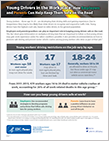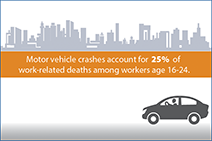MOTOR VEHICLE SAFETY AT WORK
Young Drivers at Work

Young workers – those age 16-24 – are developing their driving skills and gaining experience. Due to inexperience they may be less likely than older drivers to recognize and respond to traffic risks. Employers and parents/guardians can play an important role in keeping young drivers safe on the road.
What do we know about young drivers in the workplace?
Key Facts and Stats
- Young workers’ driving restrictions on the job vary by age.
- Workers age 16 and under in non-agricultural jobs may not drive for work.
- Workers age 17 may drive in non-agricultural jobs, but are limited by time and task.
- Generally, workers age 18 to 24 are allowed to drive on the job, but those under age 21 may not drive a commercial motor vehicle across state lines.1
- Drivers age 16 to 24 have the highest crash rate, based on miles driven, in the general population.
- From 2011-2015, 470 workers age 16 to 24 died in motor vehicle crashes at work, accounting for 26% of all work-related deaths in this age group.2
What labor laws affect young workers who drive as part of their jobs?
Driving time limits for 17-year-old workers who may drive as part of their job
Federal child labor laws limit the amount of driving 17-year-old workers can do in non-agricultural jobs.3 (Laws that cover agricultural jobs apply only to workers under age 16.) Driving time may not exceed 33% of the workday and is limited to daylight hours. Also, driving time may not exceed 20% of the workweek. Check our fact sheet for examples of driving time limits. Check your state’s child labor laws for possible additional restrictions.4
17-year-old workers may drive on public roads as part of their job on an occasional and incidental basis if they:
- Successfully complete a state-approved driver education course
- Have a valid state driver’s license
- Have no record of moving violations (e.g., speeding) at the time of hire
- Drive a vehicle that does not exceed 6,000 pounds gross vehicle weight and is equipped with seat belts for all occupants
17-year-old workers may not:
- Make urgent or time-sensitive deliveries, such as pizza deliveries
- Make route deliveries or route sales
- Tow another vehicle
- Drive more than a 30-mile radius from the primary place of work
- Be hired to transport goods or passengers
- Transport more than 3 passengers, including employees of the employer
- Make more than 2 trips away from the primary place of work in any single day to transport goods and other employees
- Drive as their main job duty
How can you keep young workers safe when they drive for work?
Employers
Employers: Use recommended strategies to develop programs and policies that follow safe-driving laws for young workers.
- Before hiring a young worker to drive:
- Check that the applicant has a state license valid for the type of driving their work will require.
- Check the applicant’s driving record for moving violations, impaired driving, and license suspensions.
- Make sure the applicant has completed a state-approved driver education course (if the driver is under age 18).
- Before assigning a young worker to drive:
- Make sure the driving assignment follows state graduated driver licensing (GDL) laws (e.g., restrictions on night driving and transporting other teens).
- Provide driver training at the time of hire that includes making young drivers aware of the safety features of the vehicle they will be driving.
- For less-experienced drivers, consider implementing policies that are more restrictive than the requirements outlined in laws (e.g., limitations on towing a trailer or driving certain types of vehicles).
Resources for employers:
Occupational Safety & Health Administration (OSHA)
Get information on rules for employers, young workers, parents, and educators.
Federal Motor Carrier Safety Administration (FMCSA)
Review hours-of-service rules related to driving, including maximum driving time for property- and passenger-carrying vehicles.
Youth Rules!
Learn about the rules in your state.
For a full list of recommendations and resources, download the Young Drivers in the Workplace fact sheet.
Parents
For parents: Take the following actions to model safe-driving behaviors and discuss driving expectations.
- Schedule on-the-road driving sessions to assess driving skills.
- Help your young driver learn to recognize traffic risks, anticipate risky situations and quickly spot developing problems.
- Know the law.
- Familiarize yourself with child labor laws that limit young workers’ driving on the job, and share this information with your young driver.
- Learn about state graduated driver licensing (GDL) laws that may affect your young driver’s ability to drive for work in some situations. GDL restrictions are designed to keep novice drivers safe.
- Discuss driving-related tasks involved in your young worker’s job.
- Ask if their employer has policies, procedures, and job training for the safe operation of motor vehicles. If these have not been discussed or provided to your young driver, make sure they ask their supervisor for guidance.
Resources for parents:
Teen Driver Source
Obtain free teen driver safety information and downloadable resources for parents, teens, policymakers, educators, and researchers.
DriveitHOME
Get resources to help your teen become a safer driver.
SaferCar.gov
Get information on your state’s teen licensing requirements.
Choosing the best vehicle for your teen
Learn which new and used vehicles are safest for teen drivers.
For a full list of recommendations and resources, download the Young Drivers in the Workplace fact sheet.
- Page last reviewed: September 18, 2017
- Page last updated: October 16, 2017
- Content source:
- National Institute for Occupational Safety and Health Division of Safety Research


 ShareCompartir
ShareCompartir

